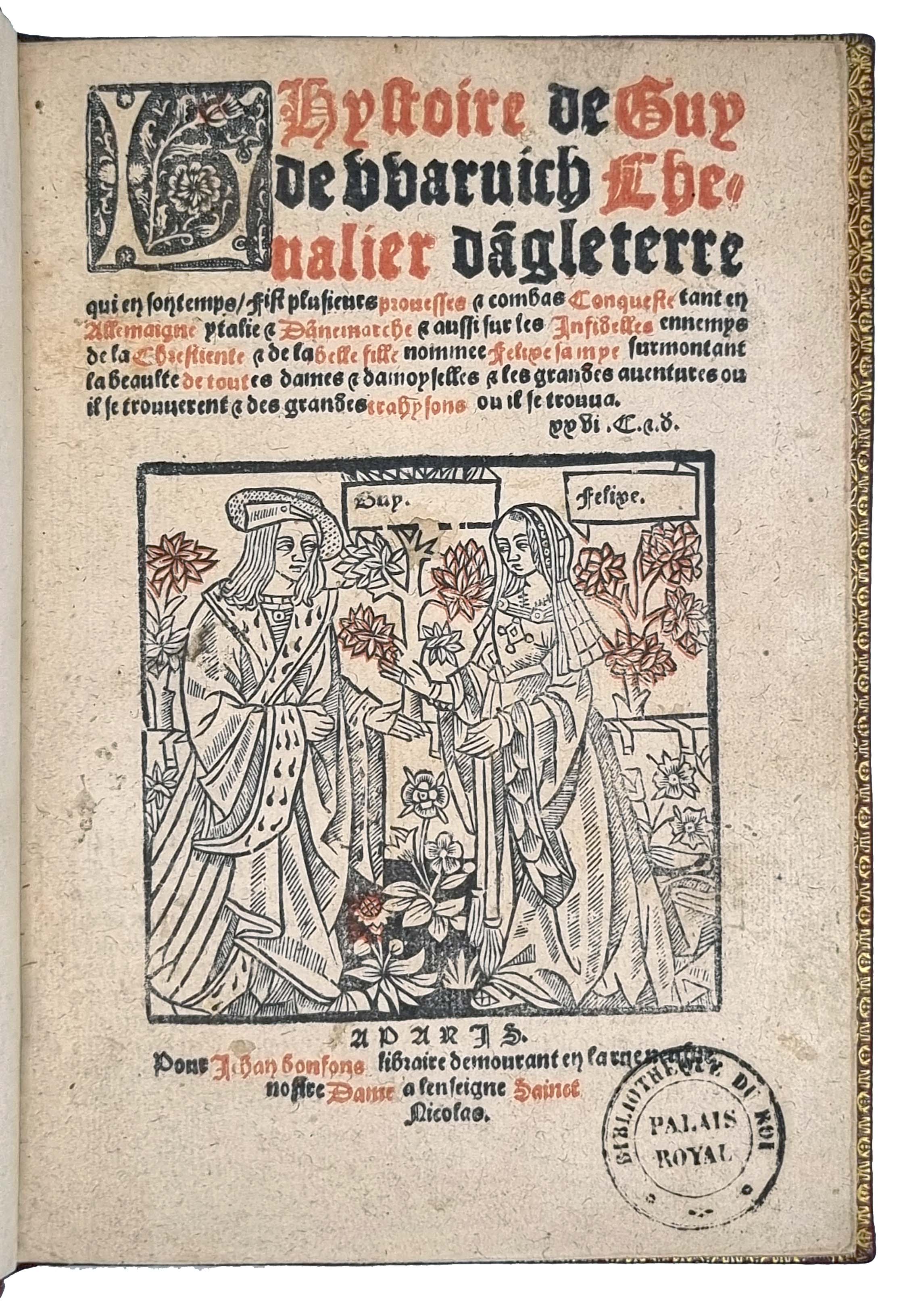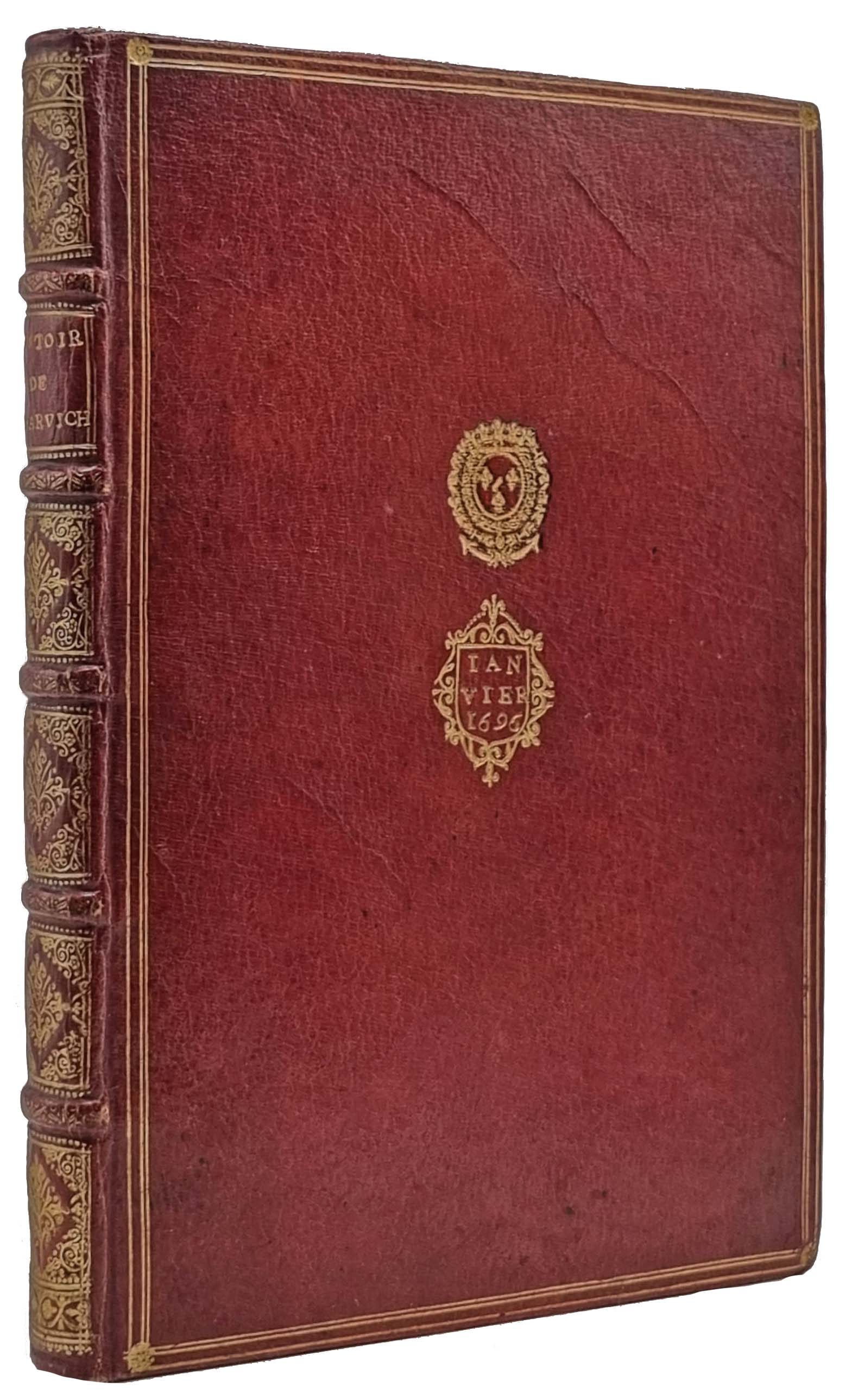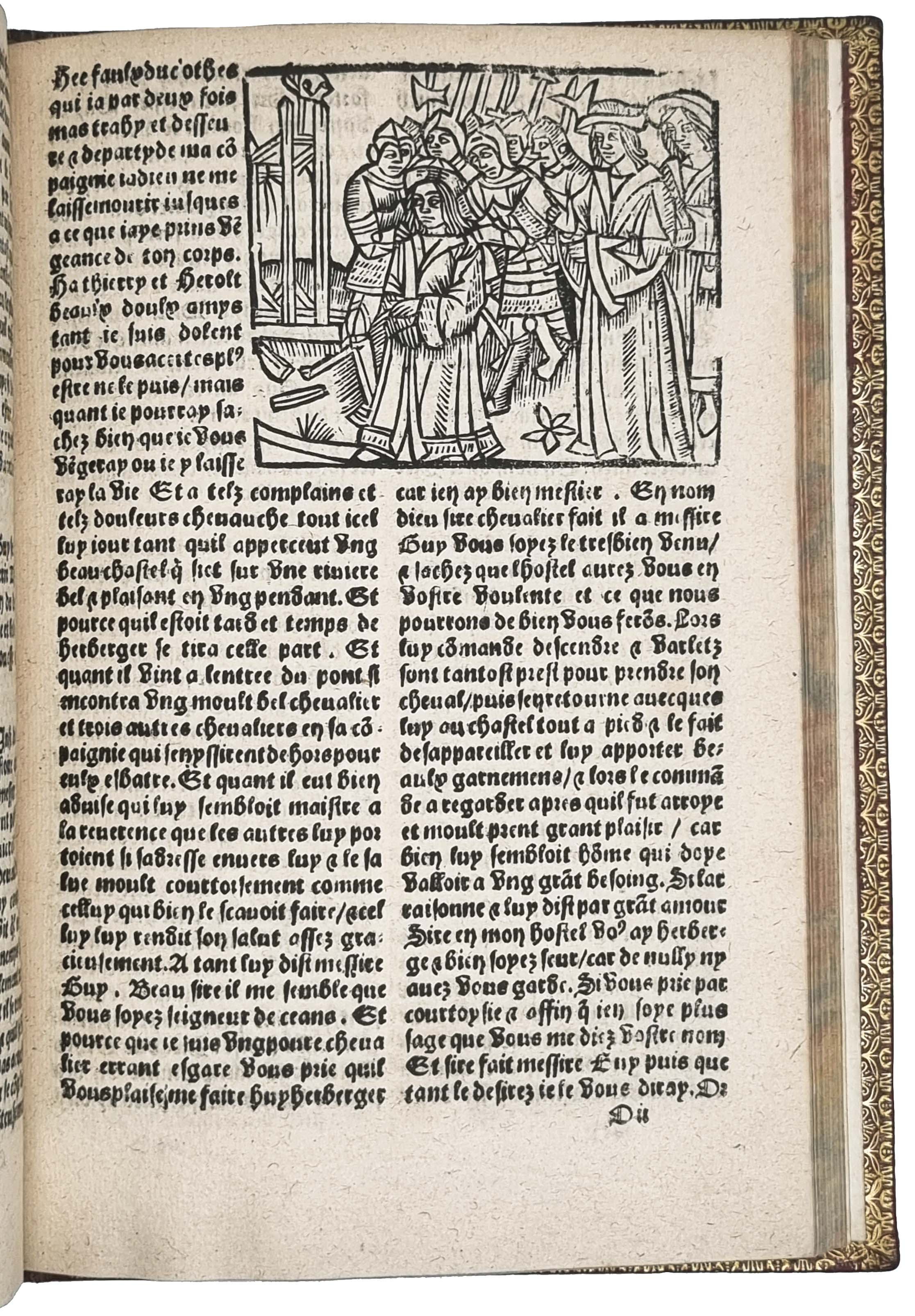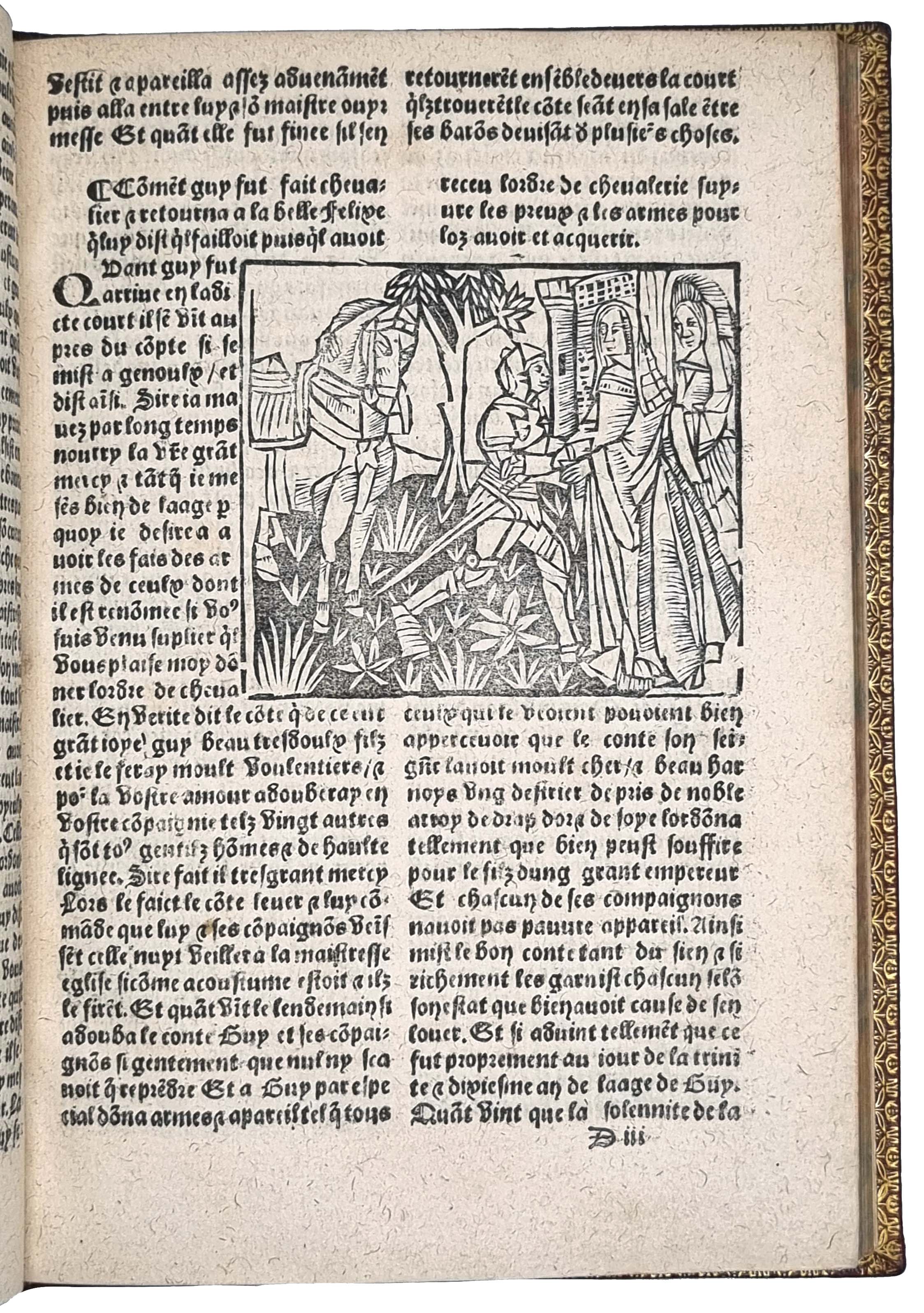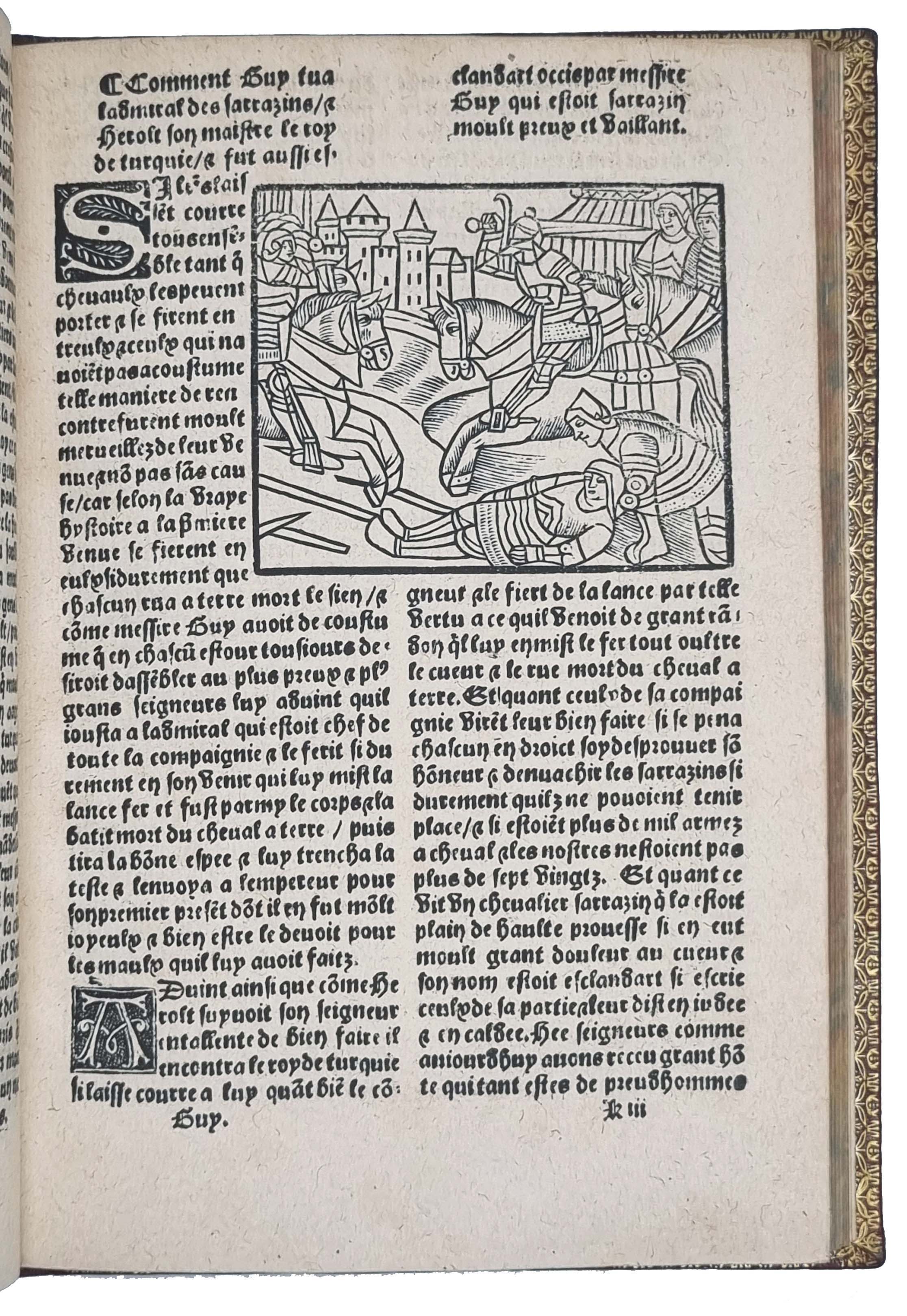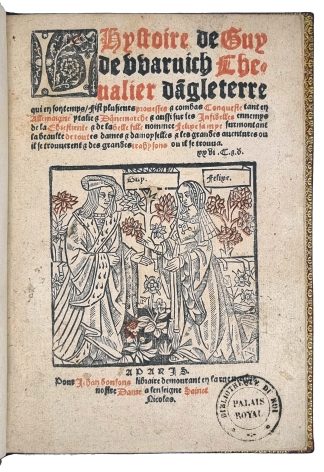WARWICK, Guy de
ENGLISH CHIVALRY IN A FRENCH ROYAL COPY
L\'hystoire de Guy de Waruich chevalier d’Angleterre
Paris, pour Jean Bonfons, [1550]£75,000.00
4to. 106 unnumbered leaves. A-E4, F8, G-I4, K8, L4, M8, N4, O8, P-Q4, R8, S4, T8, U6. (Quire K misplaced after Quire G.) Lettre Bâtard. Title printed in red and black with large white on black criblé woodcut initial ‘L’, woodcut illustration on title also printed in red and black, 25 woodcut illustrations in text, some repeated, fine white on black criblé woodcut initials in two sizes, stamp of the ‘Bibliothèque du Roi. Palais Royal’ in lower margin of title, booklabel of Ganay (crowned eagle in gilt) on pastedown, that of Jean Bonna below, shelf mark ‘3g G’ in late seventeenth hand on fly. Light age yellowing. A fine most beautiful copy in late 17th-century French red morocco by Luc-Antoine Boyet, covers bordered with a triple gilt rule, shield gilt at centres gilt lettered with ‘Janvier 1696’, the arms of the Comte de Toulouse gilt above [Olivier pl. 2609, 1], spine with gilt ruled raised bands, richly gilt in compartments, title lettered in gilt, edges and inner dentelles gilt, marbled endpapers, all edges marbled and gilt.
A wonderful, most beautiful copy, with remarkable provenance, of this extraordinarily rare chivalric romance concerning the English knight Guy de Warwick, almost certainly the only surviving copy in private hands and one of three known copies; the other two are held at the Bibliotheque National de France (one of which is substantially damaged).This copy of this work epitomises all the elements of bibliophilic desirability; it is beautifully printed with wonderful illustration, it was exceptionally bound by the Royal binder for a group of the most discerning bibliophiles, it has exceptional royal provenance, and is of the utmost rarity.
The work was bound by Luc-Antoine Boyet (who would shortly after become the Royal binder in 1698) for a member of a very select group of bibliophiles known as ‘Les Curieux’ made up of at least four members, Duvivier, Leriche, La Vieuville, and an as yet unidentified ‘Grand Curieux’. Isabelle de Conihout and Pascal Ract-Madoux describe them in detail, for the first time as a group, in the “Reliures Francaises du XVII. Chefs-D’Oeuvres du Musée Condé” pp 64-110. The books bound for this group were exclusively important and extremely rare works in French or works translated into French and were bound by Luc-Antoine Boyet in what they describe as an ‘archaïsantes’ style. The identical gilt shield with a date between 1695-6 (here Janvier 1696) occurs on many of these binding, see Conihout Ract-Madoux page 65 figure 1. The tools on this binding also correspond to those given by Conihout Ract-Madoux as those of Boyet’s gilder, most notably the central fleuron on the spine (p. 110 figure 2) and the roll used on the inner dentelle p. (p. 110 figure A). These tool occur on the almost identically gilt spine of No. 26 in the catalogue which has the date 1695. Conihout Ract-Madoux suggest that the great bibliophile Jerome Duvivier was at the heart of this group of collectors and it is possible that this book was bound for him as he rarely signed his books, whereas the others in the group were prone to do so.
This volume then made its way into the library of Louis Alexandre de Bourbon, Comte de Toulouse, the youngest son of Louis XIV and his mistress Madame de Montespan. Louis Alexandre was created Count of Toulouse in 1681 at the time of his legitimation, and, in 1683, at the age of five, grand admiral. Though his father had legitimated him and his three surviving siblings, and even declared his two sons by Madame de Montespan fit to eventually succeed him to the throne of France, this was not to be, as immediately after Louis XIV’s death the Parlement of Paris reversed the king’s will.
Guy of Warwick is the English hero of a popular Romance in England and France from the 13th to 17th centuries. The story of Sir Guy is considered by scholars to be part of the romances of English heroes that form a loose corpus of Medieval literature that in general deals with the locations, characters and themes concerning England, English history, or English cultural mores, and shows some continuity between the poetry and myths of the pre-Norman or “Anglo-Saxon” era of English history as well as themes motifs and plots deriving from English folklore. Following tests of his skill and strength with dragons, monsters, giants, a great boar and the legendary Dun Cow, earning him the hand of his beloved, Guy comes to regret his violent past, and embarks on a pilgrimage to the Holy Land, and, on his return, secludes himself in a hermitage in repentance. The chronicles of Thomas Rudborne and John Hardyng treat Guy as an historical figure (cf. Richmond 1996, ch. 4,5). Thus, like King Arthur and Robin Hood, Guy became a figure of legend, and the text became increasingly popular through the 18th and 19th centuries. The 25 fine woodcuts in this copy were either commissioned for this edition, or, as seems more likely from the fact their size makes them extend beyond the column widths, were designed to be used interchangeably in other chivalric works. They differ considerably in iconography, style and format from those of the Paris 1525 edition printed by Regnault
A wonderful copy of this most rare and beautiful work.
Brunet II, 1833 (this copy). Du Verdier p. 539; USTC 51683 ‘no known surviving copy’. Isabelle de Conihout and Pascal Ract-Madoux “Reliures Françaises du XVII. Chefs-D’Oeuvre du Musée Condé” pp 64-110. Unrecorded in Brun, Martin or Fairfax Murray.In stock


